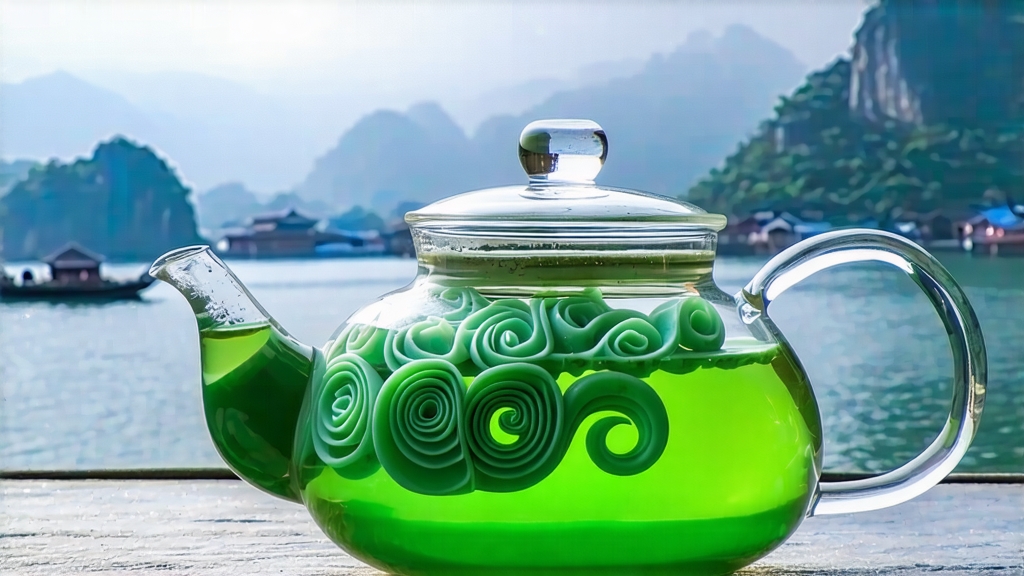
Biluochun, whose name translates literally to “Green Snail Spring,” is one of China’s ten most celebrated teas, yet it remains curiously under-represented on Western tea menus. Hailing from a micro-region where the Yangtze River delta meets the East China Sea, this jade-green, downy-spiral tea carries within its tiny curls the perfume of apricot blossoms, the salinity of lake breezes, and 1,200 years of continuous refinement. To understand Biluochun is to witness how Chinese green tea can express terroir with the same precision that Burgundy expresses Pinot Noir.
Historical roots
The first verifiable mention appears in the Tang dynasty treatise “The Classic of Tea” by Lu Yu, but local monks on Dongting Mountain insist that pilgrims were already offering “Xia Sha Ren Xiang” (literally “scary fragrance”) to Guanyin in the seventh century. The modern name was reportedly bestowed by the Kangxi Emperor during his 1699 southern tour; after tasting the infusion, he found the rolled leaf resembled a tiny snail and the harvest coincided with the spring equinox, hence “green snail of spring.” Court records show that 15 jin (8 kg) were immediately reserved for the Forbidden City, launching a 300-year monopoly that pushed the tea’s price above silver by weight.
Micro-terroir: two hills and a lake
Authentic Biluochun comes only from Dongting East and West peaks in Lake Tai, Jiangsu Province. The lake acts as a vast heat reservoir, delaying night-time chill and prompting the formation of amino acids that translate into sweetness. Thin mist filters ultraviolet light, encouraging the bush to produce more chlorophyll and fragrant volatiles. Finally, the inter-cropping of tea with apricot, peach, and loquat trees—an intentional agro-forestry system—allows pollinating blossoms to fall onto the leaf surface, lending a fruity note impossible to replicate elsewhere. Attempts to cultivate the same cultivar in Sichuan or Guizhou yield pleasant green teas, yet cuppers can detect the absence of lake air and floral drift within seconds.
Cultivar and plucking calendar
The local landrace is a small-leaf Camellia sinensis var. sinensis locally called “Xie Cha,” distinguished by an unusually high ratio of bud to first leaf. Picking begins when the overnight temperature stays above 10 °C, usually between the Qingming and Grain Rain solar terms (early April). Only the bud and the immediately adjacent half-expanded leaf are taken; one kilogram of finished tea demands 70,000 such sets, all plucked before ten o’clock so that the morning dew acts as a natural protective film against mechanical bruising.
Crafting the spiral: six hours from garden to wok
Within thirty minutes of plucking, the fragile leaf is spread 3 cm thick on bamboo trays set in the shade of the picking shed. This brief withering reduces surface moisture by 10 %, softening cell walls for the critical “sha qing” (kill-green) step. A 220 °C cast-iron wok is wiped with a tuft of fresh tea leaves to season the surface; once the first wisp of pine-scented smoke rises, 250 g of fresh leaf are tossed by hand. The master’s palm never touches the metal—only the tea—using a flicking motion that simultaneously dehydrates and sets the spiral shape. After four minutes the leaf is hot enough to sting, yet still pliable; it is transferred to a wicker hoop where two artisans roll it against the basket’s weave, coaxing the iconic curl. The process alternates between wok and hoop three times, dropping the moisture to 30 %. A final low-temperature bake at 70 °C for 40 minutes locks in fragrance while preserving the silvery down that gives the dry leaf its hoary glow.
Grading nomen to culture
Unlike many Chinese teas whose grades are tied to leaf size, Biluochun is classified first by picking date and second by bud density. Pre-Qingming “Special Grade” possesses at least 95 % unopened buds, each curl no longer than 1.1 cm. “Grade One” allows the first leaf to expand to 1.5 cm, while “Grade Two” harvested after Grain Rain shows a 1:1 bud-to-leaf ratio and a darker olive tone. Connoisseurs speak of “one bud, one world,” claiming that a single top-grade curl unfurls in the cup to reveal a miniature landscape of lake, mist, and blossom.
Water